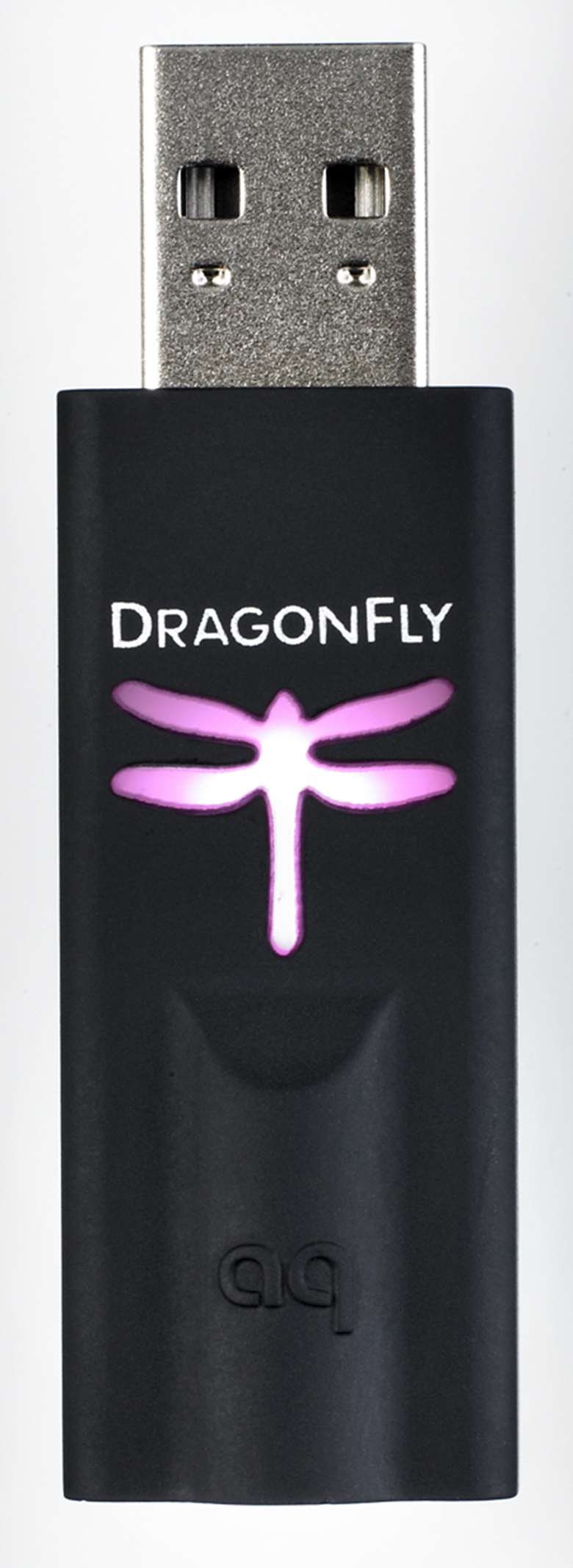AudioQuest DragonFly: compact USB convertor bridges computer and hi-fi
Andrew Everard
Tuesday, November 27, 2012

It’s not the first such device, but the DragonFly has some cutting-edge technology
An industry has sprung up devoted to getting music from computer to hi-fi system: yes, you can simply run a cable from the headphone socket of your computer to a line input on just about any audio system, but in general such outputs tend to sound less than entirely convincing, and are also prone to interference, so better ways should be sought.
Optical audio connection from the computer into a suitable digital to analogue converter is one very good way, in that the DAC is isolated from any electrical interference, but computers with such outputs are relatively rare. Or you can find amplifiers and DACs able to connect directly with a USB socket on your computer: the amplifier then becomes the sound card – the audio output device – for your computer.
You can also buy USB plug-in audio devices with an analogue output for £20 or less, but rather more upmarket is the £215 DragonFly USB DAC from AudioQuest, a company until now best-known for its wide range of cables. This can be used to provide a line output to a hi-fi system or drive a pair of headphones, packs the kind of audio technology more commonly found in expensive standalone digital-to-analogue converters.
It uses asynchronous USB transmission, implemented in Streamlength software running on a TI processor, enabling its internal clock to take charge of how data is delivered to its conversion, thus reducing distortion-inducing jitter between computer and DAC clocks. If you like, the DAC ‘sucks’ data from the computer at a rate that suits it, rather than working hard to handle what it’s being fed.
In fact, there are two clocks here, one to handle content at 44.1kHz and 88.2kHz, the other for 48kHz and 96kHz: it’s much ‘cleaner’ to deal with simple multiples rather than resampling content to fit a single clock.
Also crammed inside the DragonFly is one of the most respected digital-to-analogue conversion technologies around, the 24-bit ESS Sabre conversion chip, capable of handling content at up to 96kHz/24-bit high-resolution audio. It’s a solution more associated with high-end AV receivers, Blu-ray players and standalone DACs.
Downstream of this is a Burr-Brown headphone/line amplifier, using a 64-step analogue volume control ‘driven’ by the volume setting on the computer to which the DragonFly is connected.
PERFORMANCE
Yet with all that crammed in, the DragonFly remains tiny: it’s just 65mm long, 17mm wide and 10mm thick, and weighs 22g. And set-up is simple on both Windows 7/XP and Mac OSX Snow Leopard, Lion and Mountain Lion computers: with the DAC connected, it’s just a matter of setting it as the audio output device, and you’re done.
The logo on the device lights up to show the sampling rate on which it’s working – red for standby, green for 44.1kHz, blue 40Khz, amber for 88.2kHz and magenta for 96kHz – volume is adjusted on the computer in the usual way (or set to maximum for line-out into an amplifier) and that’s about it.
AudioQuest provided a 5m length of its Big Sur interconnect for this test, terminated with a 3.5mm stereo plug at one end to suit the DragonFly’s output, and two standard phono plugs at the other for my amplifier, so I was able to test the unit both as a headphone amplifier and run through my main system.
In both implementations the DragonFly proved highly convincing, driving my B&W P3 headphones extremely well – I’m already planning how well that will work out when travelling! – and sounding really rather good when connected in through a line input on my Naim SuperNait amplifier and then out to the big PMC speakers.
Using a variety of software players, including iTunes and Songbird, the DragonFly made my MacBook Pro sound every bit like a proper CD player, and even more amazingly sounded more than respectable when used with a £200 netbook I sometimes use for travelling, running Songbird and streaming music from my network storage.
The netbook is a bit noisier (in the electrical sense) than the MBP, but the sound quality possible through this little DAC is still remarkable: big, powerful and tight bass, gorgeous dynamics and a excellent tonality for voices and instruments alike, allied to excellent bite and treble sparkle.
It’s a sound one could willingly enjoy as part of a main home hi-fi system, provided you don’t mind a cable snaking from computer to hi-fi – the 5m Big Sur interconnect AudioQuest supplied would be almost as expensive as the DragonFly itself! – and as a means of driving a pair of headphones from a computer, either while travelling or just for some private listening, this little device is simply excellent.
If those applications appeal to you – as they do to me – the DragonFly is recommended without reservation.
SPECIFICATIONS
AudioQuest DragonFly
Type USB DAC
Price £215
Input USB
Output 3.5mm stereo socket, fixed or variable level, for amplifier or headphones
Sampling rates supported 44.1kHz, 48kHz, 88.2kHz, 96kHz
Accessories supplied Carrying pouch
Dimensions (WxHxD) 1.7x1x6.5cm
www.audioquest.com







